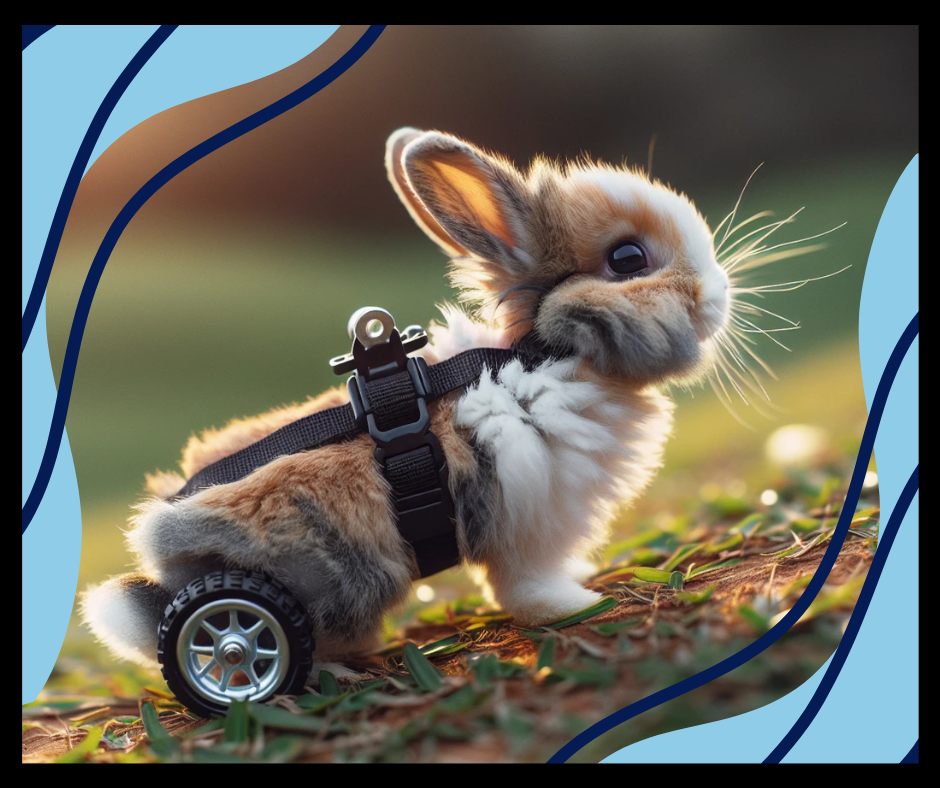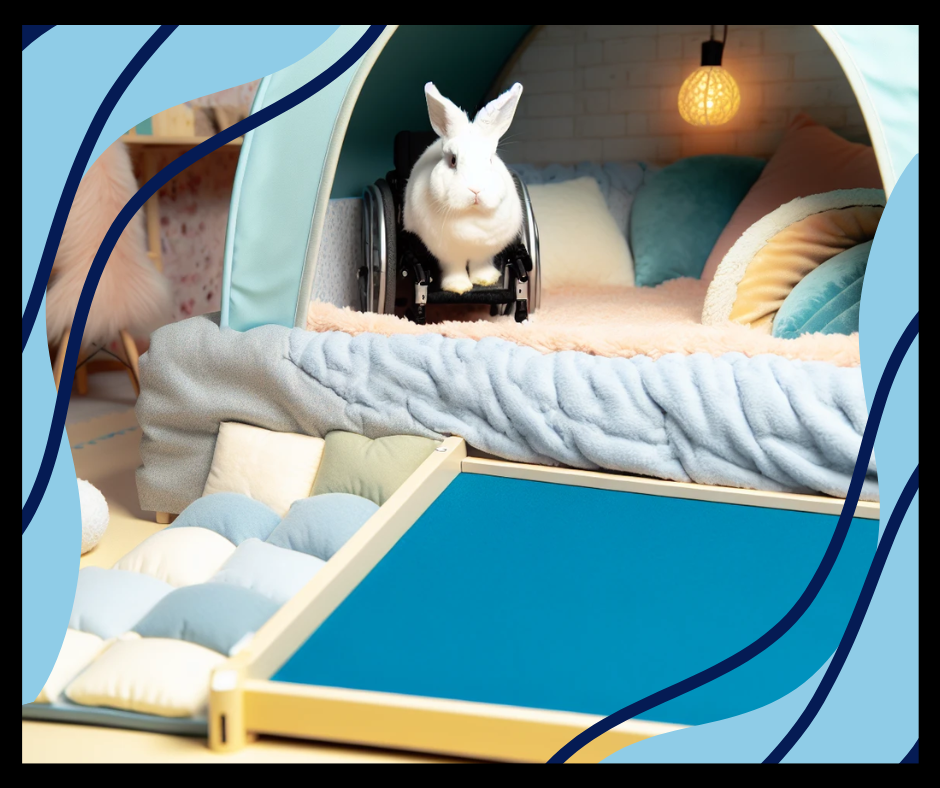Imagine waking up one day to find your beloved pet rabbit struggling to move their hind legs. Panic sets in as you try to understand what’s happening. Paralysis in rabbits can be a distressing and challenging experience for both the rabbit and its owner.
However, with the right knowledge and care, many paralyzed rabbits can continue to lead happy lives. This guide aims to provide vital information on understanding, managing, and treating rabbit paralysis.
Key Takeaways
-
Understanding and managing paralysis in rabbits requires knowledge of its causes, symptoms, treatments, and preventive measures.
-
A veterinarian should make a diagnosis to determine the underlying cause for suitable treatment. Physical therapy and alternative therapies may also be beneficial for paralyzed rabbits.
-
With appropriate testing, treatment & care, many paralyzed rabbits can lead fulfilling lives with an outlook that varies based on the cause of paralysis. Caregivers must access professional support to cope emotionally with such challenges.
Understanding Rabbit Paralysis

Rabbits can suffer from paralysis, which involves a loss of movement and sensation in one or more areas of their body. This can be debilitating and even life-threatening if left untreated. It can manifest as partial or complete paralysis, and in some cases, it’s called paresis, which is a slight or severe partial paralysis of the hind limbs.
Contrary to popular belief, paralysis is not a death sentence for rabbits. With correct medical care, a paralyzed rabbit can live for many years and still have a satisfying life. Quality of life should not be compromised, and appropriate treatments should be taken for their well-being.
Grasping the different causes and symptoms of rabbit paralysis is fundamental for appropriate care and management. Injuries to the back legs, congenital or age-related diseases, and various neurological diseases and conditions can cause rear-end paralysis in rabbits. Hence, accurately identifying the underlying issue is paramount for providing the best care for your rabbit.
Causes of Paralysis in Rabbits
Trauma, degenerative processes, and infections, such as E. cuniculi, can cause paralysis in rabbits. Injuries to the head, spine, or limbs can result in paralysis, including fractures, dislocations, or damage to the brain and spinal cord. Spinal injury, as well as conditions like spondylosis or intervertebral disc disease, can also affect the spine and cause mobility issues.
Blood tests, physical examinations, and scans are employed to identify potential underlying causes of paralysis in rabbits. A precise diagnosis is key to providing suitable treatment and care that can notably enhance a rabbit’s quality of life. Overlooking infections like E. cuniculi or degenerative processes should be avoided as these could have serious consequences if not treated.
Identifying Symptoms
Symptoms of paralysis may include difficulty moving, loss of balance, and inability to stand or jump properly. Paralysis is most commonly observed in the hind legs of rabbits, significantly impacting their agility and mobility.
The initial indications of paralysis in rabbits may include sudden onset of general weakness, diminished limb and tail movement, and pain, which may lead to hind legs falling. Hind limb weakness is a crucial symptom to monitor in these cases.
Early recognition of these symptoms can aid in seeking immediate medical attention and enhance your rabbit’s prognosis. Close monitoring of your rabbit’s behavior and physical condition is vital to ensure early identification of paralysis symptoms and timely treatment.
Consult with a veterinarian if you notice any signs of difficulty moving, loss of balance, or inability to stand or jump, as these may indicate the onset of paralysis.
Diagnosing Paralysis in Rabbits

Once you’ve identified the potential symptoms of paralysis in your rabbit, it’s time to seek professional help from a veterinarian. Diagnosing rabbit paralysis involves physical examinations, scans, and tests to identify underlying causes, such as E. cuniculi. Your vet will likely administer pain medication and anti-inflammatory drugs and perform X-rays to assess the extent of the injury.
Diagnostic tests, like the blood titer test, are essential for determining the cause of paralysis in rabbits. Surgical interventions to restore hind-end mobility are generally considered risky and rarely successful, so it’s vital to rule out other health issues, like kidney disease, before considering surgery. Your veterinarian will assist you during the diagnostic process and help determine the optimal treatment for your rabbit.
E. Cuniculi and Its Role in Paralysis
E. cuniculi is a microsporidian parasite linked to neurological problems in rabbits, affecting their nervous tissue, although not all infected rabbits exhibit symptoms of illness. The parasite is transmitted through the ingestion of spores present in contaminated urine, and the shedding of spores occurs intermittently in the urine of infected rabbits.
E. cuniculi can cause:
-
Renal disease
-
Central nervous system disease
-
Neurological disease (previously: Neurological problems)
-
Paralysis in rabbits
Research suggests that approximately 60-62.5% of infected rabbits may demonstrate clinical signs such as neurological or ophthalmic symptoms, but the infection may also be subclinical, meaning that rabbits may not exhibit any signs of illness. Appropriate diagnosis and treatment of E. cuniculi are necessary to control its impact on your rabbit’s health and overall well-being.
Treatment Options for Paralyzed Rabbits

Treatment options for paralyzed rabbits may include pain medication, physical therapy, and alternative treatments such as acupuncture. The choice of treatment depends on the underlying cause of paralysis and the rabbit’s overall health.
Pain-relieving medications, anesthetics, and gastric protective agents may be prescribed, along with alternative therapies like acupuncture and massage for pain management.
Physical therapy serves as an efficient treatment for rabbit paralysis, providing physical and emotional advantages. It helps improve mobility, maintain or improve joint range of motion, and enhances the rabbit’s ability to move and hop. Furthermore, physical therapy may help slow the progression of joint issues in elderly and disabled rabbits.
Physical Therapy and Alternative Treatments
Physical therapy and alternative treatments can be beneficial for paralyzed rabbits, potentially increasing mobility and improving their quality of life. Beneficial physical therapy exercises for paralyzed rabbits include:
-
Passive range of motion exercises
-
Massage therapy
-
Hydrotherapy
-
Assisted walking to promote mobility
Alternative therapies like microcurrent electrical therapy, cranial electrotherapy stimulation, cold laser therapy, and acupuncture are suggested for paralyzed rabbits. These therapies can provide:
-
Pain relief
-
Address musculoskeletal issues
-
Aid in wound healing
-
Stimulate the rabbit’s body
The efficacy of alternative treatments may vary depending on the particular case and underlying cause of paralysis, but they have shown positive results in many rabbits.
Assistive Devices and Adaptations
Assistive devices, such as wheelchairs, can help paralyzed rabbits maintain mobility and independence. These devices support and elevate the rear legs, enabling rabbits to move safely and comfortably. Furthermore, specialized wheelchairs, like the All Terrain Bunny, can help rabbits navigate different terrains and environments.
When choosing an assistive device for a rabbit, you should consider the following factors:
-
The rabbit’s individual needs and challenges
-
The device’s functionality
-
Its size and fit
-
Safety
-
Durability
-
Ease of maintenance
With the right device and regular physical therapy, many paralyzed rabbits can regain some degree of mobility and continue to lead active lives.
Caring for a Paralyzed Rabbit at Home

Caring for a paralyzed rabbit at home requires adjustments to their living environment, hygiene maintenance, and close monitoring of their health. Implementing comfortable bedding and ensuring hygiene maintenance are necessary modifications for the living area of a paralyzed rabbit. Providing multiple layers of comfortable bedding, such as fleece or flannel, can offer the necessary support and comfort.
In addition to creating a comfortable living space, monitoring your rabbit’s food intake, bladder control, and overall health is crucial. Proper feeding and bladder management are of utmost importance for maintaining your rabbit’s well-being.
By considering these factors and making the necessary adjustments, you can help ensure a comfortable and healthy life for your paralyzed rabbit.
Preventing Pressure Sores and Maintaining Hygiene
Preventing pressure sores and maintaining hygiene is critical for ensuring the comfort and well-being of a paralyzed rabbit. To prevent pressure sores, you can:
-
Periodically change your rabbit’s position
-
Provide them with a designated area, such as a “day bed” or spot on the couch, to rest in while watching television.
-
Lightly massage the hind legs and tickle the feet to maintain nerve and muscle activity, thus slowing down muscle atrophy.
These measures will help keep your paralyzed rabbit comfortable and healthy.
To ensure proper hygiene for a paralyzed rabbit:
-
Sprinkle cornstarch on areas with dry poop or hay stuck to the fur and comb it out.
-
Use plates or shallow bowls for food and small bowls for water to avoid accidents.
-
Thoroughly clean the rabbit’s living area at least once a week.
-
Groom the rabbit daily to maintain a healthy coat and prevent tangles.
Feeding and Bladder Management
Proper feeding and bladder management are key to preserving the health of a paralyzed rabbit. The most suitable food options for a paralyzed rabbit include:
-
High-quality fresh hay
-
Fresh vegetables
-
Rabbit pellets
-
Treats such as organic baby food
It’s important to provide a diet with a high fiber content to prevent gut stasis.
A paralyzed rabbit should follow the same feeding schedule as a healthy rabbit, ensuring they have a balanced diet and monitoring their food intake. If the rabbit has a decreased appetite, syringe feeding a pellet slurry or baby food carrots may be beneficial. By closely monitoring your rabbit’s diet and bladder control, you can help maintain their overall health and well-being.
The Prognosis for Paralyzed Rabbits

The outlook for paralyzed rabbits can be optimistic, with many leading fulfilling lives despite their condition. Various factors, such as:
-
Aging
-
Obesity
-
Lack of exercise
-
Injuries to the back or legs
-
Degenerative processes like spondylosis and osteoarthritis
-
Trauma to the back
May influence a rabbit’s prognosis. With appropriate testing, treatment, and care, many rabbits with paralysis can survive and even regain enough function to lead a normal life.
The average lifespan of a paralyzed rabbit may vary based on the cause of paralysis and the rabbit’s general health. Consulting with a veterinarian specializing in rabbit care can provide a more precise prognosis and help you determine the best course of action for your rabbit’s needs.
Coping with Emotional Challenges
Taking care of a paralyzed rabbit could potentially induce feelings of helplessness, frustration, and sadness. Seeing your rabbit unable to move or engage in usual activities can be upsetting.
Furthermore, the persistent care and attention needed to meet their needs can be emotionally taxing. To cope with these emotional challenges, seeking support from veterinary professionals and fellow rabbit owners is essential.
Various sources of professional support are available for caregivers of paralyzed rabbits, such as Disabled Rabbits, The House Rabbit Society, and Unusual Pet Vets. Online support groups, like ‘Help for Head Tilt Hoppers’ and ‘Caretakers of Disabled and Special-Needs Rabbits’ on Facebook, can also offer invaluable advice and encouragement.
By accessing these resources and engaging with a supportive community, you can better navigate the emotional challenges of caring for a paralyzed rabbit.
Summary
Understanding and managing paralysis in rabbits is a complex and emotional journey. By recognizing the symptoms, seeking prompt, professional help, and providing appropriate care, you can help your paralyzed rabbit lead a fulfilling life.
With the support of veterinary professionals, fellow rabbit owners, and a compassionate approach, you can overcome the challenges of caring for a paralyzed rabbit and ensure their comfort and well-being.
Frequently Asked Questions
How do you treat a paralyzed rabbit?
Hydrotherapy, mental stimulation, and regular repositioning are important for paralyzed rabbits. Additionally, massage, acupuncture, and skeletal manipulation provided by a qualified veterinarian may help improve the rabbit’s mobility and quality of life.
How long does it take for a rabbit to recover from paralysis?
Veterinary care may allow for recovery from paralysis within six months, although it can take up to a year.
Why is my rabbit floppy and not moving?
It appears that your rabbit is suffering from either Hypotension (low blood pressure) or dehydration, causing it to be floppy and not moving. With these conditions being serious and potentially life-threatening, it is critical to wrap the rabbit warmly and seek veterinary assistance as soon as possible.
Is there a cure for E. cuniculi-induced paralysis in rabbits?
Unfortunately, there is no cure for E. cuniculi-induced paralysis in rabbits, but proper care and management can help improve their quality of life.
How can I prevent pressure sores in my paralyzed rabbit?
To prevent pressure sores, often change your rabbit’s position, provide comfortable bedding, and massage and tickle their hind legs to maintain activity.
Learn Rabbit Care, Tips, and Tricks!
Learn more about caring for your bunny with us. We’ve got everything from rabbit hutches to essential care tips.
For more information on rabbit care, visit our website: therabbithop.com.
Join our community and become a bunny care expert!



